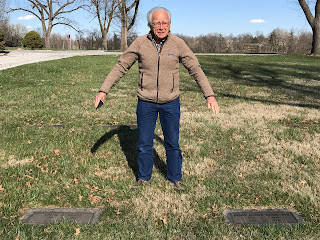Chasing History: Exploring My Ancestral Roots - Post #5 by Tonya Graham McQuade
What family history trek is complete without a visit to the cemetery? In this case, that meant visiting TWO cemeteries in Kirksville – one where Bailis and Mary Ann Petree and three of their children were buried, the other where their daughter Lettie Petree Bragg and her husband were buried. That one took a bit more searching – but we were glad we made the effort. Bailis and Mary Ann's daughter Nora, my great grandmother, is buried with her husband at Forest Lawn Cemetery in Southern California.
The Petrees were a large family, with ten children – all of whom survived until adulthood. Father Bailis was born in Franklin County, Indiana, in 1840; Mother Mary Ann, in Greene County, Tennessee, in 1843. Bailis and Mary Ann met in Andrew County, where both of their families had moved. Both families were farmers seeking to carve our lives for themselves in this area of northwestern Missouri known as the Platte Purchase - added to Missouri in 1836 when the U.S. government purchased land from several Native American tribes - where they raised their children, worked their fields, harvested their crops, cared for their livestock, and built a community.
Now, here's some further back family history (most taken from the first chapter of the non-fiction book I am working on – A State Divided: The Civil War Letters of James Calaway Hale and Benjamin Petree):
Mary Ann’s father, James Calaway Hale – the writer of the Civil War letters (remember him?) - was born in Greene County, Tennessee, on September 26, 1820. The youngest of twelve children, he was just fourteen when his father Meshack Hale, a veteran of the War of 1812, passed away. His mother, Mary Kincheloe Hale, outlived her husband by thirty-two years, the last few years being cared for by two of James’s older brothers, Lewis and Enoch. Both Meshack and Mary had been born in Virginia but moved to Tennessee, along with various other family members, after receiving a land grant in Bedford County on the waters of Big Flat Creek.
There James was born and grew up, alongside his seven older brothers and four older sisters, all but one of whom lived to adulthood. He learned how to farm from his father and brothers and at some point also learned coopering skills, which he put to use making money later in life (he lists that as his occupation in both the 1850 and 1860 census). On March 3, 1842, James married Elizabeth Caroline Brown - daughter of John Wesley Brown and Margaret Kincheloe, both of Tennessee – who had been born on September 19, 1821 in Washington County, Tennessee.
Following their marriage, James and Elizabeth continued living for a time in Greene County, where they had two daughters: Mary Ann “Mollie” Hale (Jan 1843) and Amanda “Manda” Hale (Feb 1848). However, by December 1849, they moved to Andrew County, Missouri, where their son McDonald “Mc” Hale was born, soon to be followed by daughters Marguerite (1852) and Eliza (1856). Two other sons, Isaac and John, died there as infants.
Around the time that Mary Ann was being born, her future husband Bailis was moving with his family from Franklin County, Indiana to Andrew County, where - when Bailis was just four years old - his mother Mary Snowden Petree died. Five years later, in 1849, his father Henry and older brothers John and Benjamin headed off to California for the Gold Rush, leaving Bailis and his two younger sisters (Margaret and Mary) living with the Schooling family in Jefferson Township, Andrew County (1850 Census). Bailis’s father returned after one year; his brother Benjamin, in 1857. Soon after that, Benjamin purchased a farm, and by 1860, his brother Bailis and the two younger sisters were living with him (1860 Census), even though their father and his new wife and children were living nearby. Also in 1860, Benjamin married Missouri-born Lucy Ann Earls, and over the next few years they had three sons - all born before he was drafted in late 1864.
In March of 1862, Bailis and Mary Ann married in Nodaway Township, Andrew County, Missouri. That September, her father volunteered to fight in the Civil War – writing many letters over the next few years to his wife and children, and many others to Bailis and Mary Ann. Those letters form the core of the two books I am working on – the non-fiction version mentioned above, and the historical fiction version, Missouri Daughter, which begins and ends with Mary Ann.
Bailis and Mary Ann had ten children, all born near Savannah in Andrew County, over the following twelve years: James Henry (1863-1932), Louis Edward (1865-1936), John Ernest (1867-1934), McDonald (1870-1897), Mary Elizabeth (1872-1916), Oran Adrian (1874-1961), Charles Bailis (1876-1970); Letitia “Lettie” Elvira (1879-1970), Nora Elma (1881-1970), and Jessie Louella (1884-1943). In 1891, they moved to 808 E. Washington Street in Kirksville, Missouri, where the children attended school, eight of the ten later graduating from the Missouri State Normal School I wrote about in an earlier post.
Bailis and Mary Ann eventually watched most of their children move away, several to far-away California, others to Kansas and Illinois, but they continued living on E. Washington Street. By 1910, they moved to the house where their oldest son James had previously lived with his family, 820 E. Washington Street, and after Bailis died in 1910, Mary Ann continued living at that address until she died in 1923. Her obituary, dated April 26, 1923, described her as “one of the best known residents of this city” and said she “became ill with influenza about a month ago and was afterwards taken down with pneumonia. She was eighty years old.”
When my grandmother, Margaret Ruth Traughber Graham, visited Kirksville in 1970 to attend her Aunt Lettie’s funeral, she took this photo at her grandmother's grave:
















_crop.jpg)
No comments:
Post a Comment